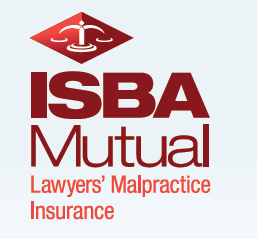August 2015 • Volume 103 • Number 8 • Page 50
Thank you for viewing this Illinois Bar Journal article. Please join the ISBA to access all of our IBJ articles and archives.
Loss Prevention
20 Quick and Dirty Risk Management Ideas for Lawyers
This risk-management speed drill will keep best practices top of mind. Ready, set, go!
 PowerPoint presentations too often resemble a school play - very loud, very slow, and very simple.
PowerPoint presentations too often resemble a school play - very loud, very slow, and very simple.
- Edward Tufte1
The pitfalls of PowerPoint are well-known to denizens of conference rooms everywhere. Slides crammed to bursting with text - bulleted main points with dense nests of sub- and sub-sub- and sub-sub-sub-points in progressively unreadably tiny font sizes. Slides festooned with cringe-making clip art (Screen Beans, I'm looking at you2) and pulsing with goofy, distracting animation. Slides with colors and pre-fab background schemes that assault our corneas and the principles of geometry.
Endless, aimless decks of PowerPoint slides seem to have taken the place of effective communication. Like my labrador Henry, who cannot respond to commands or greet friends unless he has a stick, toy, or other portable bird-substitute in his mouth, we seem to be unable to share information without a remote controller in our hands and a screen over our shoulders. We have given our presentation skills away, and the sordid boon of PowerPoint has taken their place.3
Even creative types, apparently, are purveyors of death by PowerPoint, according to two Tokyo architects who observed that
[A]rchitects talk too much! Give a microphone and some images to an architect - or most creative people for that matter - and they'll go on forever! Give PowerPoint to anyone else and they have the same problem.4
So Astrid Klein and Mark Dytham of Klein Dytham architecture created a simple presentation format called PechaKucha,5 in which a presenter shows 20 images, each for 20 seconds - the slides advance automatically, so no lingering is possible. In February 2003, Klein and Dytham held their first PechaKucha 20x20 event in their own "gallery/lounge/bar/club/creative kitchen."6 Today, PechaKucha Nights happen in over 800 cities throughout the world, with people getting together to share their art, projects, ideas, or anything that matters to them - the founders of PechaKucha say that the key is to "present something you love."7
What I love, nerdily enough, is risk management - and I also like the idea of not boring my audience to tears. So here, in the spirit of PechaKucha, are 20 bite-size risk management ideas and reminders for lawyers.
Risk Management for Lawyers x 20
1. Practice with the best lawyers you possibly can. Their good habits and good reputation will rub off on you. They likely will have fewer problems and claims to rub off on you, too.
2. Be a Jack (or a Jill) of a few trades. Choose a few areas of law in which to concentrate your practice. This will enable you to become competent and confident in your chosen areas of practice, market your firm more efficiently and effectively, and avoid the substantive errors that are the cause of so many malpractice claims.
3. Don't dabble. Ignore the siren song that tells you that "Any good lawyer should be able to handle a simple _____." This is not true, and even if it were, how would you know if it's a "simple" matter or not? You won't know what you don't know until it gets you into trouble.
4. Be picky about clients. You will have difficult clients - everyone does, sooner or later - but there are a few prospective clients that are predisposed to stiff you for fees, sue you for malpractice, and make you miserable in the meantime. Often the warning signs are clear in your very first meeting. Send these would-be clients "I'm not your lawyer" letters and let them go.
5. Harness the awesome power of "no." Saying "no" to the clients, matters, projects, and causes that aren't right for you will afford you the capacity to say "yes" to the clients, matters, projects, and causes that are.
6. Use engagement letters. Would you ever advise your clients to provide their services without a carefully drafted, signed agreement in hand? Practice what you preach, for all the reasons that you preach it.
7. Never let your clients wonder if you've forgotten them. Provide your clients with regular status reports. Keeping them reasonably informed is your ethical duty and it is also essential for good client relations.
8. Set reasonable expectations for client communications. Do not allow your clients to persist in the unsustainable expectation that you will be available to them "24/7." Advise new clients of your firm's office hours, and introduce them to other members of your team who can help if you're not available. The point is not that you will ignore calls after 5 p.m., or fail to respond to true emergencies when they arise, but rather to set reasonable standards that you have some hope of meeting.
9. Provide timely responses to client messages and calls. Do not allow client messages and calls to languish unanswered. Especially when the client is difficult, there is a tendency to procrastinate. Resist the temptation - the situation will not improve with age.
10. Confirm important decisions in writing. Write a Confirming Your Assignment ("CYA") letter memorializing important client decisions, especially when your client decides to act against your advice. If you're saying, "I don't have time for that CYA stuff," remember that dealing with professional liability claims will take some (completely unbillable) time (and your deductible), too.
11. Document your files well. Life is uncertain and you never know when you'll end up under the bus - figuratively or literally. If your client makes a claim against you, will your files demonstrate that you handled the matter competently and carefully? And if something happens to you, are your files sufficiently well documented that a colleague could pick up where you left off?
12. Find a calendaring system that works for you and use it. Having a good calendaring system is not good enough - it must be used, accurately and consistently, by every member of your firm.
13. Bill your clients regularly and thoughtfully. Your bill is the only status report some clients will ever read. Mistakes here make your clients wonder what else you're messing up.
14. Follow up on accounts in arrears promptly. Unpaid bills can signal other, deeper problems. Your client may be broke, or furious at you about something, and either way, it is better to find out sooner rather than later.
15. Avoid fee suits at all costs. Think very, very carefully about suing a client for unpaid fees - such suits typically draw malpractice counterclaims and you will want to make sure you are on solid ground, both with respect to your handling of the underlying matter and with respect to insurance coverage, as some policies exclude claims arising from fee suits.
16. Take care of business. Disengaging from the business aspects of law practice makes you vulnerable to embezzlement and other embarrassing and expensive problems.
17. Watch out for your colleagues. Our profession has a high incidence of chemical dependency and mental health problems. Be alert to signs that a fellow lawyer or colleague is in trouble. The Illinois Lawyers Assistance Program can help - see www.illinoislap.org.
18. Value and empower your support staff. They can make you and your work product look good - or not - and they are on the front lines when it comes to client relationships. Make sure they know - and know that you know - the importance of their role in your practice.
19. Do not cover up or lie about mistakes. Everyone makes mistakes, and they are easiest and cheapest to fix on the day they are discovered. Do not hide them or ignore them - address them appropriately and promptly, with input from your law firm colleagues and your professional liability insurer.
20. Know how your professional liability insurance works. Be certain you understand what constitutes a "claim" under your policy, because failure to report a claim in a timely manner puts you at risk of losing coverage for that claim.
You're up!
And now, it's your turn at the podium. Send me your risk management tips - concisely stated, of course - and I'll share the best ones in an upcoming issue of the Illinois Bar Journal.

Karen Erger is vice president and director of practice risk management at Lockton Companies.
- Edward Tufte, PowerPoint Is Evil, Wired (Sept. 2003), http://archive.wired.com/wired/archive/11.09/ppt2.html
- These faceless clip-art characters - little stick figures shaking hands, smashing computers with hammers, etc. - were ubiquitous in the salad days of PowerPoint and were officially retired in 2011 by their maker, the A Bit Better Corporation (http://www.bitbetter.com/). But Screen Beans live on, zombie-like, in the dim gloom of conference rooms everywhere.
- See William Wordsworth, "The World Is Too Much With Us" ("The world is too much with us; late and soon, Getting and spending, we lay waste our powers; Little we see in Nature that is ours; We have given our hearts away, a sordid boon!")
- See http://www.pechakucha.org/faq and explore the site to see examples of PechaKucha presentations.
- I don't know about you, but there are tons of foreign words and phrases that I know, but won't say aloud for fear of mispronouncing them. For example, the French phrase "ne plus ultra" means "the last word," but I have yet to speak even the first word of it for fear of saying it wrong and looking like a pretentious goof. Anyway, here's a fun little video that explains how to pronounce PechaKucha (Japanese for "chit chat"): https://www.youtube.com/watch?v=Bf7WUGwuysQ
- Your law firm needs one of these, doesn't it?
- See http://www.pechakucha.org/faq.

